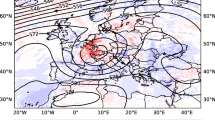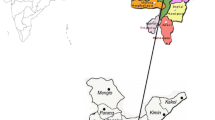Abstract
Short-term rainfall prediction with high spatial and temporal resolution is of great importance to rainfall-triggered natural hazards such as landslide, flood, and debris flow. An analogue-based forecasting method may be able to provide short-term radar rainfall predictions, or “nowcasts,” in which the probability distribution of the atmospheric state at a given location in the future is estimated based on a set of past observations. Expensive computations and diverse atmospheric interactions across multiple spatial scales, however, limit the application of this method. This study employs a physically based, empirical ensemble rainfall nowcasting model to obtain ensembles from historical rainfall fields. To do this, we consider meteorological factors, rainfall spatial distributions, and the temporal evolution of rainfall patterns. Cross-correlation is used as a measure of the similarity between the spatial distributions of two rainfall patterns, and the movement rate of rain, with respect to both direction and distance, is used to compare the patterns temporally. A moving window scheme is used to reduce the computational load, with rainfall data providing most reference values. The relationship between different scales and rainfall forecasts is further explored by cascade divisions. While smaller analogue scales indicate better forecasts in this study, the optimal analogue scale will vary for different rainfall events. This study is only a start in incorporating multi-scaled analogue into rainfall nowcasting analysis, and a great deal of more effort is still needed to build a realistic and comprehensive analogue-based rainfall prediction model.











Similar content being viewed by others
References
Alpert P, Shafir H (1989) Meso[ggr]-scale distribution of orographic precipitation: numerical study and comparison with precipitation derived from radar measurements. J Appl Meteorol 28(10):1105–1117
Anders AM, Roe GH, Durran DR, Minder JR (2007) Small-scale spatial gradients in climatological precipitation on the olympic peninsula. J Hydrometeorol 8(5):1068
Anderson T, Ivarsson KI (2016) A model for probability nowcasts of accumulated precipitation using radar. J Appl Meteorol 30(1):135–144
Atencia A, Zawadzki I (2013) A comparison of two techniques for generating nowcasting ensembles. Part I: lagrangian ensemble technique. Mon Weather Rev 142(11):4036–4052
Atencia A, Zawadzki I (2015) A comparison of two techniques for generating nowcasting ensembles. Part Ii: analogs selection and comparison of techniques. Mon Weather Rev 143(7):150330095311001
Austin GL, Bellon A (1974) The use of digital weather radar records for short-term precipitation forecasting. Q J R Meteorol Soc 100(426):658–664
Bellon A, Austin GL (2010) The evaluation of two years of real-time operation of a short-term precipitation forecasting procedure (sharp). J Appl Meteorol 17(12):1778–1787
Berenguer M, Corral C, Sánchezdiezma R, Semperetorres D (2005) Hydrological validation of a radar-based nowcasting technique. J Hydrometeorol 6(4):532–549
Berne A, Delrieu G, Creutin JD, Obled C (2004) Temporal and spatial resolution of rainfall measurements required for urban hydrology. J Hydrol 299(3–4):166–179
Bowler NE, Pierce CE, Seed AW (2006) Steps: a probabilistic precipitation forecasting scheme which merges an extrapolation nowcast with downscaled nwp. Q J R Meteorol Soc 132(620):2127–2155
Burlando P, Montanari A, Ranzi R (1996) Forecasting of storm rainfall by combined use of radar, rain gages and linear models. Atmos Res 42(1–4):199–216
Casati DB, Wilson LJ, Stephenson DB, Nurmi P, Ghelli A, Pocernich M et al (2008) Forecast verification: current status and future directions. Meteorol Appl 15(1):3–18
Collier CG (1981) Objective rainfall forecasting using data from the united kingdom weather radar network. Nowcasting: Mesoscale Observ Short-Range Prediction 165:201
Collier CG (1986) Accuracy of rainfall estimates by radar. Part I: calibration by telemetering raingauges. J Hydrol 83(3–4):207–223
Dai Q, Han D, Zhuo L, Huang J, Islam T, Srivastava PK (2015) Impact of complexity of radar rainfall uncertainty model on flow simulation. Atmos Res 161–162:93–101
Dan C (2004) A bayesian state space modelling approach to probabilistic quantitative precipitation forecasting. J Hydrol 288(1):92–104
Delle Monache L, Nipen T, Liu Y, Roux G, Stull R (2011) Kalman filter and analog schemes to postprocess numerical weather predictions. Mon Weather Rev 139(11):3554–3570
Dixon M, Wiener G (1993) Titan: thunderstorm identification, tracking, analysis, and nowcasting—a radar-based methodology. J Atmos Ocean Technol 10(10):785
Dool HMVD (1994) Searching for analogues, how long must we wait? Tellus Ser A Dyn Meteorol Oceanogr 46(3):314–324
Foresti L, Pozdnoukhov A (2012) Exploration of alpine orographic precipitation patterns with radar image processing and clustering techniques. Meteorol Appl 19(4):407–419
Germann U, Zawadzki I (2002) Scale-dependence of the predictability of precipitation from continental radar images. Part I: description of the methodology. Mon Weather Rev 130(12):2859–2873
Gilleland E, Ahijevych DA, Brown BG, Ebert EE (2010) Verifying forecasts spatially. Bull Am Meteor Soc 91(10):1365–1373
Gires A, Onof C, Maksimovic C, Schertzer D, Tchiguirinskaia I, Simoes N (2012) Quantifying the impact of small scale unmeasured rainfall variability on urban runoff through multifractal downscaling: a case study. J Hydrol 442–443:117–128
Hamill TM, Whitaker JS (2007) Ensemble calibration of 500-hpa geopotential height and 850-hpa and 2-m temperatures using reforecasts. Mon Weather Rev 135(9):3273–3280
Hamill TM, Hagedorn R, Whitaker JS (2008) Probabilistic forecast calibration using ecmwf and gfs ensemble reforecasts. Part II: precipitation. Mon Weather Rev 136(7):2620–2632
Hamill TM, Bates GT, Whitaker JS, Murray DR, Fiorino M, Galarneau TJJ et al (2013) Noaa’s second-generation global medium-range ensemble reforecast dataset. Bull Am Meteor Soc 94(10):1553–1565
Harrison DL, Norman K, Pierce CE, Gaussiat N (2012) Radar products for hydrological applications in the UK. Water Manag 164(WM1):89–103
He X, Refsgaard JC, Sonnenborg TO, Vejen F, Jensen KH (2011) Statistical analysis of the impact of radar rainfall uncertainties on water resources modeling. Water Resour Res 47(9):1995–2021
Hering AM, Germann U, Boscacci M, Sénési S (2008) Operational nowcasting of thunderstorms in the alps during map d-phase. In: Proceedings of the 5th European conference on radar meteorology
Hill FF (1983) The use of average annual rainfall to derive estimates of orographic enhancement of frontal rain over England and Wales for different wind directions. Int J Climatol 3(2):113–129
Joss J, Schädler B, Galli G, Cavalli R, Boscacci M (1997) Operational use of radar for precipitation measurements in Switzerland. Vdf Hochschulverlag Ag An Der Eth Zürich Voltastrasse Zürich
Kober K, Craig GC, Keil C (2010) Blending a probabilistic nowcasting method with a high resolution ensemble for convective precipitation forecasts. Q J R Meteorol Soc 138(664):755–768
Liguori S, Ricoramirez M (2013) Propagation of radar rainfall uncertainty in urban flood simulations. In: EGU general assembly conference (vol15)
Messner JW, Mayr GJ (2011) Probabilistic forecasts using analogs in the idealized lorenz96 setting. Mon Weather Rev 139(6):1960–1971
Monache LD, Eckel FA, Rife DL, Nagarajan B, Searight K (2013) Probabilistic weather prediction with an analog ensemble. Mon Weather Rev 141(10):3498–3516
Panziera L, Germann U, Gabella M, Mandapaka PV (2011) Nora–nowcasting of orographic rainfall by means of analogues. Q J R Meteorol Soc 137(661):2106–2123
Reyniers DM (2008) Quantitative precipitation forecasts based on radar observations: principles, algorithms and operational systems. Brussel, Belgium
Roe GH (2005) Orographic precipitation. Annu Rev Earth Planet Sci 33(12):645–671
Schmid W, Mecklenburg S, Joss J (2000) Short-term risk forecasts of severe weather. Phys Chem Earth Part B 25(25):1335–1338
Schmid W, Mecklenburg S, Joss J (2002) Short-term risk forecasts of heavy rainfall. Water Sci Technol A 45(2):121–125
Seed AW (2003) A dynamic and spatial scaling approach to advection forecasting. J Appl Meteorol 42(3):381–388
Smith RB, Barstad I (2004) A linear theory of orographic precipitation. J Atmos Sci 61(61):1377–1391
Toth Z, Kalnay E (1993) Ensemble forecasting at NMC: the generation of perturbations. Bull Am Meteor Soc 74(12):2317–2330
Turner BJ, Zawadzki I, Germann U (2004) Predictability of precipitation from continental radar images. Part III: operational nowcasting implementation (maple). J Appl Meteorol 43(2):231–248
Wilks DS (2001) A skill score based on economic value for probability forecasts. Meteorol Appl 8(2):209–219
Wilks DS (2009) Extending logistic regression to provide full-probability-distribution mos forecasts. Meteorol Appl 16(3):361–368
Wilson JW (2004) Precipitation nowcasting: past, present and future. In: Sixth international symposium on hydrological applications of weather radar, Melbourne, pp 2–4
Wood SJ, Jones DA, Moore RJ (2000) Accuracy of rainfall measurement for scales of hydrological interest. Hydrol Earth Syst Sci 4(4):531–543
Xu JJ (1996) Statistical modeling and inference for multivariate and longitudinal discrete response data, Dissertion, University of British Columbia
Zawadzki I, Morneau J, Laprise R (2010) Predictability of precipitation patterns: an operational approach. J Appl Meteorol 33(12):1562–1571
Acknowledgements
This study is supported by the National Natural Science Foundation of China (41871299 and 41771424) and UK Newton Fund via Natural Environment Research Council (NERC) and Economic and Social Research Council (ESRC) (NE/N012143/1). The authors acknowledge the British Atmospheric Data Centre, the UK Environment Agency, and the UK Met Office for providing the datasets used in this study.
Author information
Authors and Affiliations
Corresponding authors
Additional information
Publisher's Note
Springer Nature remains neutral with regard to jurisdictional claims in published maps and institutional affiliations.
Rights and permissions
About this article
Cite this article
Zou, X., Dai, Q., Wu, K. et al. An empirical ensemble rainfall nowcasting model using multi-scaled analogues. Nat Hazards 103, 165–188 (2020). https://doi.org/10.1007/s11069-020-03964-3
Received:
Accepted:
Published:
Issue Date:
DOI: https://doi.org/10.1007/s11069-020-03964-3




